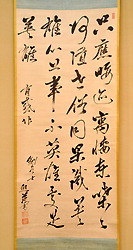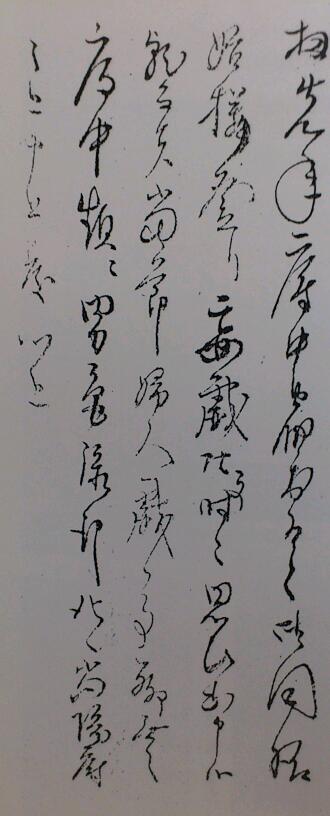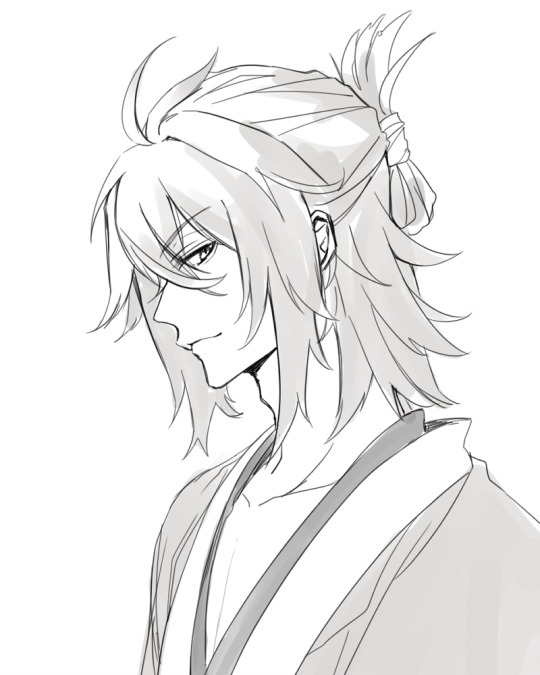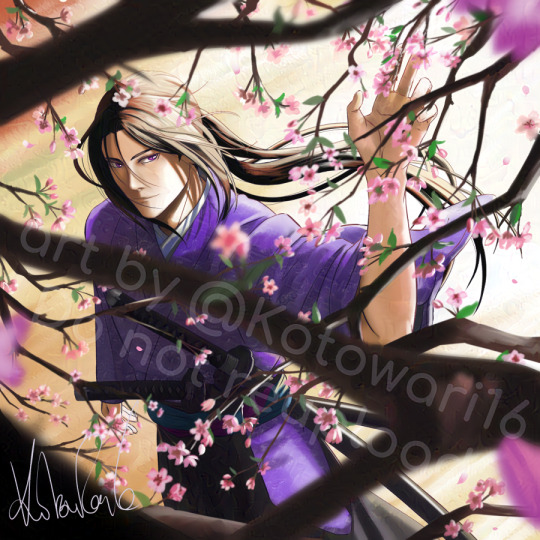Text
A hanging scroll handwritten by Shinsengumi Commander Kondo Isami is found in Kyoto


First Image: Kondo Isami's newly discovered handwritten hanging scroll is pictured here in Kyoto City on October 4, 2011. (Photo by Hanazawa Shigeto, Mainichi Japan)
Second Image: A hanging scroll handwritten by Kondo Isami, who was the Commander of the Shinsengumi. Provided by the Ryozen Historical Museum (Photographed in 2011) [source: Jiji Press]
A hanging scroll handwritten by Kondo Isami (1834-68), the Commander of the Shinsengumi who was active in Kyoto at the end of the Edo period, has been found in Kyoto. It is believed to be a Chinese poem on the theme of "heroism," written by Kondo as a token of gratitude when he borrowed money from wealthy merchants to raise funds for his activities. Only a few hanging scrolls in Kondo's handwriting have been found, and it is said to be a valuable discovery to understand who Kondo was as a person.
The hanging scroll is 196 cm long and 63 cm wide (the calligraphy is 136 cm long and 60 cm wide). An art dealer in the city had acquired the scroll in Osaka in 2008, and this month, a doctor in Onomichi, Hiroshima Prefecture, had purchased it. It was taken to the Ryozen History Museum (Higashiyama Ward, Kyoto), a history museum focusing on the Bakumatsu era, where Kimura Sachihiko, head curator of Bakumatsu history, determined that the calligraphy was authentic based on the handwriting and signature.
Although the details of the calligraphy have not yet been clarified, it expresses the feelings of a "hero" and is signed "Swordsman, Kondo.
According to Kimura, the calligraphy is similar in form to a hanging scroll (owned by the Tokyo National Museum) written around 1863, the same year Kondo and his men arrived in Kyoto from the Kanto region. It is believed to be from the same period. In the same year, Kondo and the others were given the name "Shinsengumi" in recognition of their military service, and they were engaged in cracking down on the militant fighters of the anti-shogunate movement. They sometimes forcefully borrowed money from wealthy merchants in Osaka and Kyoto and left behind such writings.
Kimura said, "There is no doubt that Kondo liked the calligraphy of Rai Sanyo, a scholar of Chinese classics, and imitated him. It shows Kondo's enthusiasm at that time when he became a samurai, which he had longed to become.
[Hanazawa Shigeto, Mainichi Japan] October 5, 2011
Discussion at SHQ
(English article: http://mdn.mainichi.jp/arts/news/20111005p2a00m0na003000c.html)
27 notes
·
View notes
Photo

Next time someone tries to tell you the shogunate opposed modernization and the Meiji Restoration is when progress started to happen in Japan, I’d like you to remember this drawing of the Tokugawa Army’s artillery on the march in Edo. Those are buglers in the front, mounted officers following them, and artillery trailing, artillery equal to a lot of what Europe had.
Credit belongs where credit is due. The Tokugawa were first, and the Meiji government wouldn’t have been able to do what it did on a national scale without the foundation the Tokugawa laid.
35 notes
·
View notes
Text

Some people were clearly more interested in the magic of photography than others. 😂 That second samurai from the left is an entire mood.
Ueno Hikoma, Ueno Sachima, and Hikoma's friends.
18 notes
·
View notes
Text
No actually no one in the Shinsengumi died ever
Okita Souji's work schedule
During the Edo period, low-ranking samurai working at Edo Castle had a "three-day shift," working two days and taking the third day off.
Working hours were shorter than now, and the work was divided into morning, evening, and night shifts.
This may sound somewhat enviable, but the pay was low, and the workers ended up working long hours at their own side jobs.
On the other hand, what was the work schedule like for the Shinsengumi, who were paid well but had to work hard?
Since there are no historical materials about the service shifts of the Shinsengumi members, I would like to speculate based on some records.
Since the Shinsengumi were often mobilized for emergencies, there were relatively few incidents, and I have referred to the events from the first year of the Genji Era to the second year of the Keio Era, when the organization seemed to be in place after the assassination of Serizawa Kamo.
Off-duty days?
In the first year of the Genji era, Tomizawa Chuemon, the village head of Hino and a fellow student, went to Kyoto and wrote in his diary that he often visited the headquarters.
According to this, on 2/2, Hijikata, Inoue, and Okita were at the headquarters from around noon to evening.
The following month, on 3/5, they attended the Peach Blossom Banquet hosted by Kondo and others. Kondo, Hijikata, Inoue, Okita, Todo and others were there and returned home the next morning.
On March 11, a cherry blossom viewing party was held. Kondo, Hijikata, Inoue, Okita, Toudou, and Takeda Kanryusai attended. After the banquet, they moved to Shimabara for an after-party, so it's likely that they returned home in the morning on this day as well.
Although we do not know the start time of either banquet, they must have been off duty that day or the next day.
The next month, on April 11, a farewell party was held for Tomizawa who had completed what he set out to do and was returning home. This was attended by Kondo, Hijikata, Inoue, and Okita. Since the party was held in the evening, it cannot be said that they were off duty.
Work days
Except for emergency dispatches such as the Ikedaya Incident, there is nothing that shows Okita's work days in the First Squad.
The mistaken arrest that caused trouble with the Higo clan was introduced in the article "Okita Souji's Apology Conference". If this was the work of the First Squad, 9/8 of Keio 1 is a work day.
On the other hand, for some reason, an attendance record still exists for Takeda Kanryusai and the 7th Squad.
Takeda was involved in the capture of Masuya (Furutaka Shuntaro) on 6/5 of the first year of the Genji era and the Akebonotei Incident on 6/10. It is believed that he belonged to the 3rd Squad at that time.
In the 7th Squad, Yano Shigetaro was captured on 5/12 in the leap month of Keio 1. On 9/12 of the following year, there is a record of Sanosuke Harada leading his unit to the Sanjo Noticeboard Incident.
It's noteworthy that in the Sanjo Noticeboard Incident, it's clear from the subsequent historical materials that Squads 3, 5, and 7 were deployed.
Although the 1st squadron was not dispatched, the other odd-numbered squads were all dispatched together, probably because they were on the same shift.
Morning shift, night shift, 3-day shift?
Then, assuming that the "Peach Blossom Banquet" was off-duty, I created a shift based on the same "three-day shift" as that of Edo Castle.
Then, the "Tomizawa's Farewell Party" was also off-duty for odd-numbered teams.
Also, Hijikata Kennosuke, a member of the Sennin Doshin (Thousand Men Army) who had come to Kyoto, visited the headquarters and held a drinking party on September 18, 1868, also off-duty, and Okita and Inoue of the First and Third Corps attended all the parties.
Furthermore, none of the days when Takeda and 7th Squad were deployed fell on off-duty days, but rather on work days.
However, 2/2, when Tomizawa visited, was a work day on this shift. Considering that Okita and the others were drinking until the evening, they may have been on a different shift before the "Peach Blossom Party," or they may have been on duty from the evening.
Since the Sanjo Noticeboard incident also did not involve the First Squad, it's also possible that they were on morning-duty on this day.
This is just a hypothesis, but I think that the Shinsengumi took turns off-duty for each even-numbered and odd-numbered squad, and that there was a morning shift and an evening shift on working days.
There is a high possibility that the work interval is a "3 days shift", but if it's based on odd or even numbers, there will be days when all employees are dispatched, so there may have been another group.
However, when Iba Hachiro went to Kyoto, he worked once every four days. Other diaries from the same period show consecutive days of work and consecutive holidays, which are irregular and depend on the organization.
The Shinsengumi's work schedule was announced in the morning, so even if there was a general schedule, it would have varied.
Incidentally, according to this schedule, the day Okita wrote a letter to his hometown informing them of Sannan's death fell on a day he was off duty.
It may have taken him a long time to write that painful letter...
References
「新選組日誌 (上)」 菊地明・伊東成郎・山村竜也
「日本人は昔から働き者?知ると深い「江戸の労働」 濱田浩一郎
「幕末武士の京都グルメ日記 「伊庭八郎征西日記」を読む」 山村竜也 幻冬舎
「慶応元年御進発御用日記 十九歳の長州出兵記録」 日野の古文書を読む会研究部会 日野市郷土資料館
「新選組史料大全」 菊地明
36 notes
·
View notes
Text
About Nanae Chrono (PMK mangaka)
Since I have seen some people confused about it, I make this post to clarify the gender of Nanae Chrono, the mangaka of Peacemaker Kurogane.
For many years, we read by articles and manga editions that Nanae Chrono was a woman, however, in late 2021 after making a Twitter account, Chrono came out as a trans man and literally put on his bio "FTM". Because he broke those news on Twitter and he's not that popular of a mangaka (sadly) many people are unaware of this fact and so continue to refer to him as "she/her" even in Japanese articles, but the truth is that he identifies as male and thus we started to refer to him in this blog as "he/him", although he hasn't said on Twitter what pronouns he prefers in English.
You can check his Twitter here (although warning he often RTs NSFW art) and see his bio to check it out!
35 notes
·
View notes
Text

Letter from Kondo Isami dated May 20, Genji 1 (June 23, 1864) to Nakajima Jirobei (中島次郎兵).
The second line from the left reads, "Male sexuality is popular" (男色流行).

Original letter
(本文略)
尚々、御家内中様御尊父始メ御勇猛之至奉恐賀候。陳者尊兄健次郎様事市ヶ谷辺江御縁談之由、恐悦至極奉存候。
次ニ下拙義も素□愚魯身不顧尽忠報国有志御募リ相成、然馬合之局中ヲ預リ、州鄙客申述頻ニ心配致ゆ���□哉意外多病相成、依而去二月肥後守殿□なるへく温泉致候様、依之罷越候処僅七八日ニ而俄ニ 肥後守殿御役替ニ付飛脚到来、其夜五十丁十六里帰京致候。
併相応度候哉当節大丈夫ニ相成候間、御懸念可被下候間敷、且乍憚一統様暫時処公然様奉願上候。
一、扨先年府中宿おいて御同様始楼登リ、妄戯仕事時々思ひ出申候。就而者当節婦人戯候事聊無之。局中頻ニ男色流行仕候。尚帰府之上申上度。以上
Translation
(Text omitted)
I would like to express my heartfelt gratitude to all of you, including your dear father, for your bravery. I am very pleased to hear of your older brother Kenjiro's marriage proposal and move to the Ichigaya area.
Next, I have been recruiting volunteers to repay the nation with loyalty without regard for my own life, and have been entrusted with the affairs of bureaucrats. I've had too many worries on my mind and I have been unexpectedly very ill. Last February, Higo-no-kami-dono asked me to visit a hot spring, so I did. After just 7 or 8 days, a courier suddenly arrived with news of Higo-no-kami-dono's change of position, so overnight I returned to Kyoto at a distance of 50 blocks and 16 ri [16 hour walk]. At the same time, I would like to express my sincere gratitude to you for your concern. For the time being, I can only offer my best wishes.
Now, I sometimes recall that last year when I was in Fuchu, we visited brothels and indulged in raunchy games. In that regard, people no longer play around with the ladies these days. Male sexuality is popular frequently throughout the headquarters. I would like to mention this to you upon my return to my home province. That is all.
Commentary
In the main text (omitted), he writes that he was disappointed in the Shinsengumi's position and its role, and that he considered disbanding the group, but was consoled, and so on. [T/N: This was before Ikedaya]
In the postscript, in addition to congratulating the Nakajima family on their happy event, he wrote that he had fallen ill due to hard work and went to a hot spring for treatment, as recommended by Katamori, but after about a week, Katamori informs him that he was to be reassigned to a different position. It is written that he returned to Kyoto, sick and beaten.
He then fondly remembers how they used to indulge in "raunchy games" together at a brothel in Fuchu, and tells them that these days there is no such thing as playing with women at all, and that "danshoku" (male sexuality) is prevalent within the Shinsengumi.
(source: www.toshizo.com)
Translator Notes
Instead of interpreting it as Kondo complaining about the prevalence of male sexuality, doesn't it sound like he's actually trying to convince Nakajima to go for male prostitutes together next time?
"I know we used to play around with women, but no one does that anymore. Here at the Shinsengumi HQ, we do male love all the time. Just something I wanted you to know before I visit you ;)" 😂
35 notes
·
View notes
Text
Okita Souji's personality according to an old newspaper article
Okita Souji had certain "habit" according to the Telegraph newspaper article. That is, a habit of mocking people.
The article goes as follows:
He had a habit of taunting others, and even when he was in practice with swordsmen who were better than he was, he would stop the one who was about to strike him on the mask and say, "There we go, there we go, that's the mask".
This was the "habit" he did in that incident at the restaurant described in the article:
"Look at this commoner's swordsmanship. Strike here, you idiot!" he knocked on his own head with his left fist.
With this, the man on guard was so angry that he slashed the tip of his sword into the wall.
Also, when fighting with the sumo wrestlers, seeing the gomenbo pole hitting the ground in vain after Okita dodged it, Okita teased them, "What was that for? The ground must be crying in pain." The angry sumo wrestlers chased after Souji and were led away from the headquarters.

The article summarizes that Okita's "habit" seemed to be a shortcoming, but it turned out to be a good thing.
If Souji had a habit of "taunting" people on a regular basis, there would be many such testimonies, but there is no such story in the testimonies of Kondo Yugoro, Yagi Tamesaburo, and others.
In the article, when Kondo Daizo (近藤大造), also a member of the Tennen Rishin-ryu, warned Souji that he would fail someday because of his arrogance, Souji replied, "You're right. I'll refrain from it", but it's a habit that he never corrected, the story goes.
If the source of this article is Kondo Daizo, it is possible that the "habit" appears only during training and fighting.
He would rile up his opponent to create an opening or keep the enemy away from the headquarters where his ill Commander was located.
This may have been Souji's special tactic rather than a "habit".
From this article, we can see not only his boldness in going alone to face the enemy, but also his cleverness. It gives us a glimpse into his personality.
I don't know if this is the reason, but the character for "intelligence" (賢) is also used in Souji's posthumous Buddhist name, "賢光院仁誉明道居士".
The scene in which Souji quickly goes to the restaurant, saying, "If we wait around too long, we will not be respected as law-enforcement", shows Souji's impatient side, while his concern for his mentor, such as his concern for the sick Isami, is also described.
He was brave and smart, and although he had a short temper, he was kind to his Commander.
Perhaps this was Souji's image at that time.
However, who was Kondo Daizo, who seems to be the source of this article? I would like to follow up when I have a chance.
52 notes
·
View notes
Text
Okita's height
Okita Souji's appearance is still a mystery.
Many people have studied his face, so let's leave that for now, but what about his height?
Many sources give his height as "5 shaku 5 sun" (5'5" or approximately 167 cm).
This seems to be based on an article titled "Another Look at Okita Souji" (沖田総司別見), which appeared in the April 1972 issue of the "Historical Research" (歴史研究) magazine.
According to that article, a man named Sanbongi Mitsuo (三本木密雄), a samurai of the Nihonmatsu domain, once met Okita Souji, and "when they were standing side by side, they turned their heads to the side and talked," and since Sanbongi Mitsuo was "5' 5" tall, it is estimated that Okita was also about 5' 5" tall.
This text was written by Endo Koukei (遠藤幸威). He said that his mother told him what his great-grandfather had heard from Sanbongi Mitsuo.
Considering that Endo was the last of the Omi Mikami clan lords, such a story must have been told among the family members.
(Incidentally, the book "沖田総司おもかげ抄" written by Mori Makiko, which is in my possession, mentions "Endo Kouzo" (遠藤幸蔵), but it seems to be a misprint.)
However, we do not know where this Sanbongi Mitsuo met Okita, in Kyoto or in Edo. The Nihonmatsu clan was also in charge of guarding Kyoto, so it's possible that he met Okita in Kyoto.
Okita was between 22 and 26 years old when he was in Kyoto, so he had already finished growing. If Sanbongi met him in Kyoto, we can almost say for certain that he was about 5'5".
However, if they met in Edo, things would be a little different.
Sanbongi Mitsuo also says that Okita disliked taking baths [T/N: the original text used "風呂", which could mean he disliked going to "bath houses" instead]. However, in "沖田総司おもかげ抄", an old woman in Kyoto who had feelings for Okita at the time said that "Okita was very clean and neat," and the author, Mori Makiko speculates that "As a boy in the Shieikan, he might have disliked taking a bath, but since he became a member of the Shinsengumi in his youth, he might have started to pay more attention to his personal appearance and cleanliness."
Indeed, considering that he accompanied Kondo Isami to Nijo Castle and other places after joining the Shinsengumi, he must have been careful about his appearance, and it's unlikely that Kondo Isami would have tolerated a filthy appearance.
If so, it's highly likely that Sanbongi Mitsuo met Okita in Edo.
It depends on when they met in Edo, but if they met when Okita was a boy, it is possible that he grew taller after that.
Yagi Tamesaburo, the second son of Yagi Gennojo's family, who lived in Mibu, Kyoto, describes Okita as "a tall, dark-skinned man with broad shoulders".
These are the 3 people Tamesaburo described as "tall":
Serizawa Kamo
Noguchi Kenji
Okita Souji
What he said about Hijikata Toshizo:
"he had a toned face with large eyes"
"he was sullen and didn't chat much"
"he was said to be the son of an apothecary, but didn't appear like one at all."
Among the Shinsengumi, Hijikata Toshizo is the only one whose height is known. A specific number is given in "両雄士伝捕遺", "he is 5 shaku 5 sun (5'5")".
The 5 shaku 5 sun is the same as Okita's, but why did Tamesaburo not refer to Hijikata as a "tall man" as well?
The average height at that time was said to be around 5'1" (155-157 cm).
Hijikata, who was more than 10 cm taller than the average height, must have been "tall" as well.
Kondo Isami was shorter than Hijikata by the amount of a topknot (162 to 163 cm), and Saito Hajime was estimated to be around 175 cm.
Shimada Kai is said to be about 6 feet tall (180 cm), and Yamazaki Susumu is also said to be tall.
At the time Okita was staying at the Yagi residence, Tamesaburo was between 13 and 16 years old, a very impressionable age, but from the perspective of the Shinsengumi as a whole, his impression of Hijikata was not that he was "tall" but that he was "moody" and "didn't look like an apothecary's son" mentioned above.
If so, Serizawa, Noguchi, and Okita would have given him the strongest impression of being "tall" among the Shinsengumi.
Some say that Okita was 5'7" (172 cm), so he may have been at least that tall. At the very least, Okita was probably taller than Hijikata.
References
新選組始末記 子母澤寛全集一 子母澤寛
沖田総司おもかげ抄 森満喜子
歴史研究 1972年4月号 新人物往来社
沖田総司伝私記 菊池明
聞き書き徳川慶喜残照 遠藤幸威
両雄士傳 補遺 橋本清淵編輯 多摩デジタル新選組資料館
Wikipedia
32 notes
·
View notes
Text

its essential to my wellbeing that i draw him
299 notes
·
View notes
Text
Translation: Hakuouki SSL (2023) - Limited edition bonus novel (Okita Souji)
I translated this weeks ago, but daily life got in my way of posting it. This short story was published in a bonus novel that came with the limited edition of the Switch version of SSL.
33 notes
·
View notes
Text

89 notes
·
View notes
Text

He who lived like the cherry blossoms 🌸
One more week until Hijikata hen starts!
I wanted to experiment with this sort of effect for a while. I think it turned out quite nicely, if you ask me.
PS: I've been really busy the past few weeks with work and planning my trip to Japan (I'm leaving in 5 days 😱 and I feel like I still have a mountain of stuff to do...). Art updates will continue to be slow until the end of April, but you'll hear me yelling about Japan instead on my main blog.
70 notes
·
View notes
Text
Happy Thai new year!
aka
Happy Songkran Festival!! 🎉🎉🎉

“Luck is not your friend today.”
His voice was cold and quiet, like a water gun of ice. Yellow-white sunlight lit his slender face and shone from the water gun that pointed at my chest.
“Run, and I will shoot you.”
*Ahem* pardon me guys. A little explanation of the festival below the cut.
To put it in the easiest way, people splash water at each other in public, or you may call it public water fight. I’m not sure of the exact reason for doing so but I guess hot weather is one of them. The festival take place around 13-15 April(the new year is the 13th though) which is the hottest month afterall. Hot, like, an inch from hell, says a Thai folk herself 🔥🔥🔥🫠
Sometimes you might found people putting powder or white clay on their face or arms, hence Hijikata is holding baby powder bottle in one of his hand. Hawaiian shirt or the flower print shirt he’s wearing is also one of the most typical Songkran fashion 🌺 Other traditional activities includes pouring water onto the elders’ hands or buddha statue. The water is usually flower-floated, so I replaced the snow in the original cg with rose petals which is one of the common flower used for the activities.
For more clear picture, you can look it up on google using “Songkran” or “Songkran festival” as keywords!
Btw, he’s soaking? WHO DARE SPLASHING WATER AT THE VICE-COMMANDER???
37 notes
·
View notes
Text
You can always tell which dead person a historian wants to fuck
4K notes
·
View notes
Text

164 notes
·
View notes
Text
17 notes
·
View notes
Text

A drawing with my fanfic's vibe. They are probably looking at Kaoru or sth.
22 notes
·
View notes